Abstract
African sleeping sickness is accompanied by a severe immunosuppression. As part of our efforts to examine the mechanisms by which this suppressive state is induced, we studied alterations in human T-lymphocyte function caused by Trypanosoma brucei rhodesiense. To this end, we used an in vitro system in which phytohaemagglutinin (PHA)-stimulated human peripheral blood mononuclear cells (PBMC) were cultured in a medium containing soluble, non-dialysable parasite products. We were able to demonstrate significant suppression of both lympho-proliferation and interleukin-2 receptor (IL-2R) expression. These effects were found to be dose-dependent and reversible after 48 hr of culture. The suppressive effects of living trypanosomes and the soluble parasite products on lympho-proliferation and interleukin-2 receptor expression were similar in that both precluded the entry of PHA-activated PBMC into the cell cycle. Eighty to ninety-eight per cent of the activated cells remained arrested in the G0/G1a (early G1) phase even 48 hr after stimulation, i.e. when last tested. Parasite-induced expression could not be overcome by the addition of recombinant human IL-2. These results suggest that immunosuppression associated with African trypanosomiasis may result from parasite-induced alteration of very early events during lymphocyte activation, leading to a virtually complete block in cell cycle progression and inhibition of IL-2R expression.
Full text
PDF
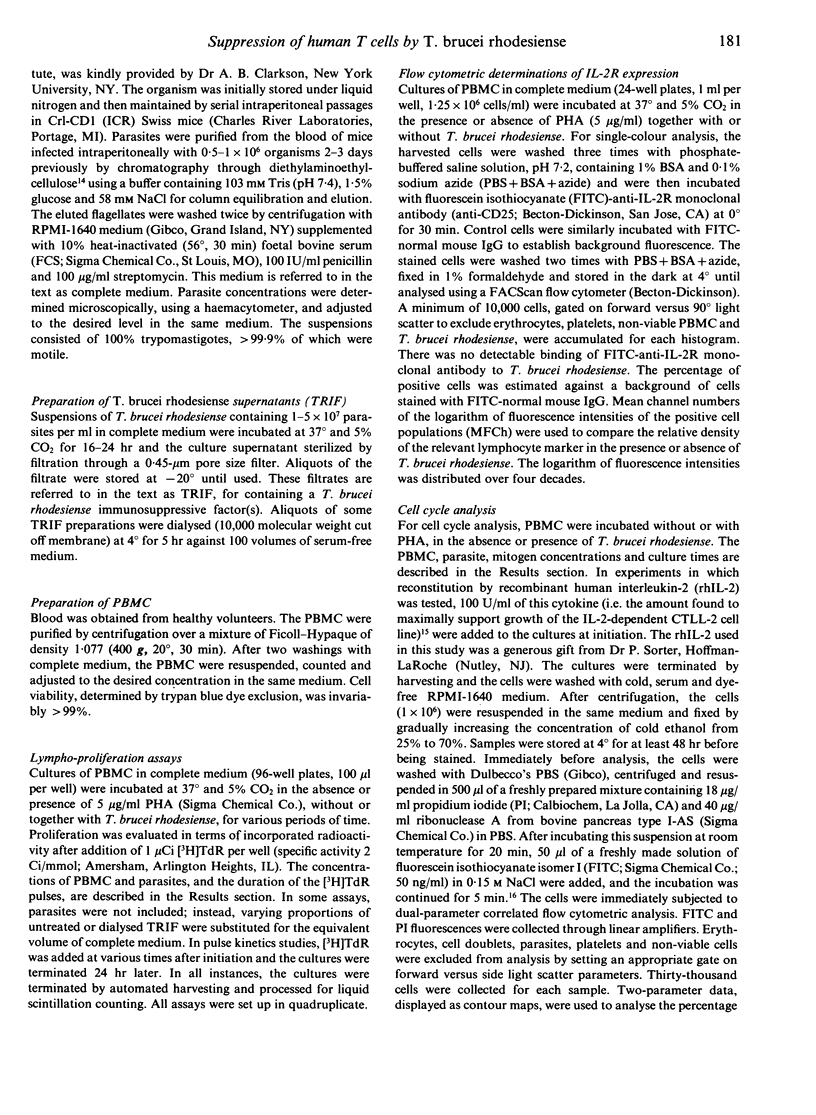
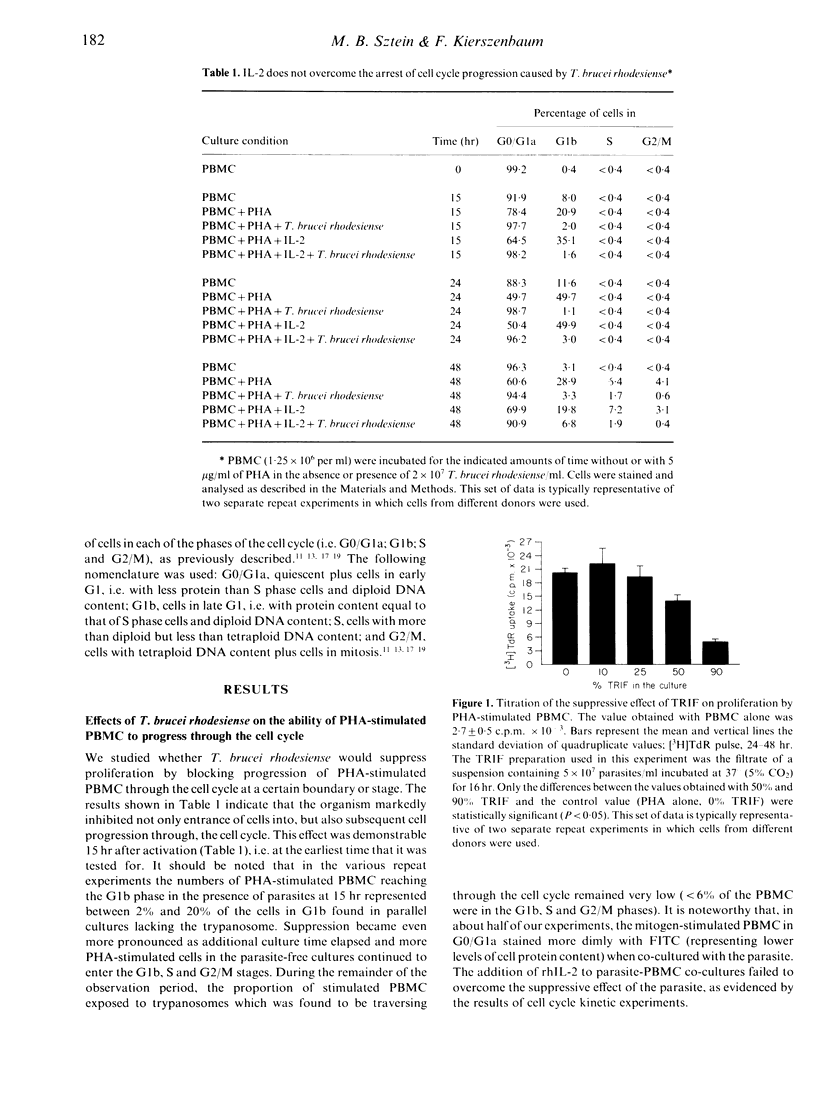
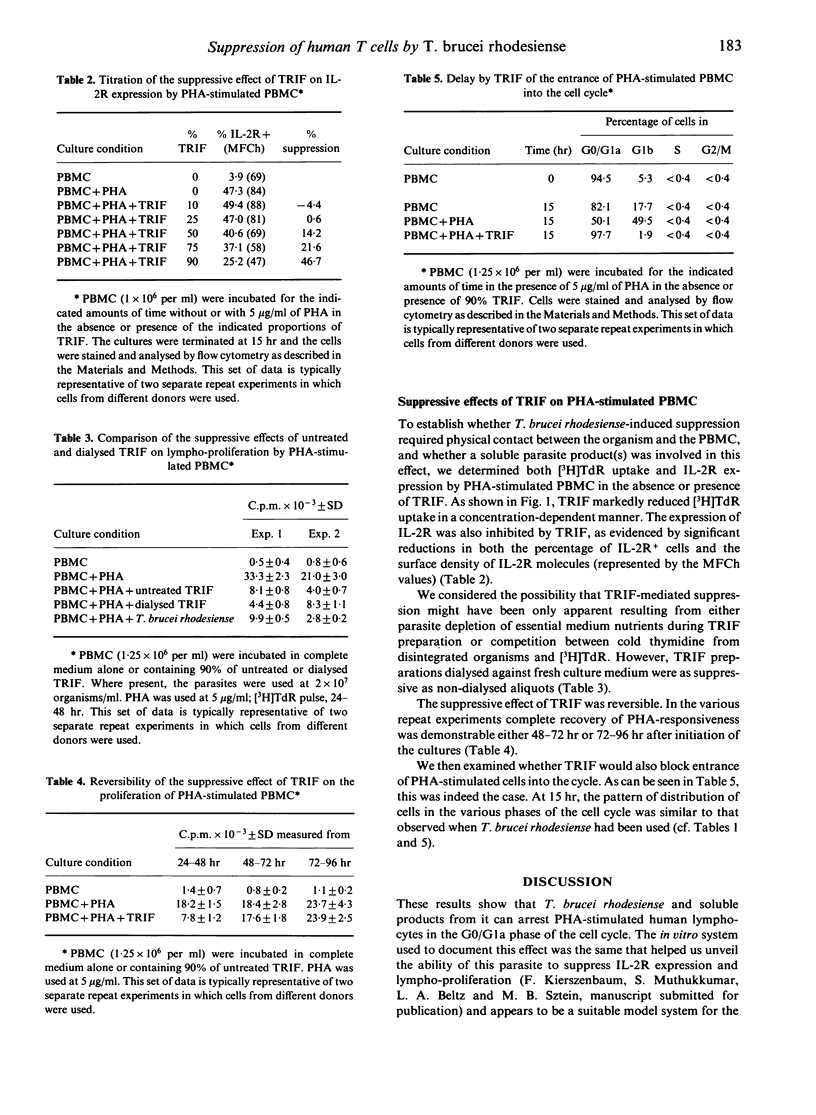
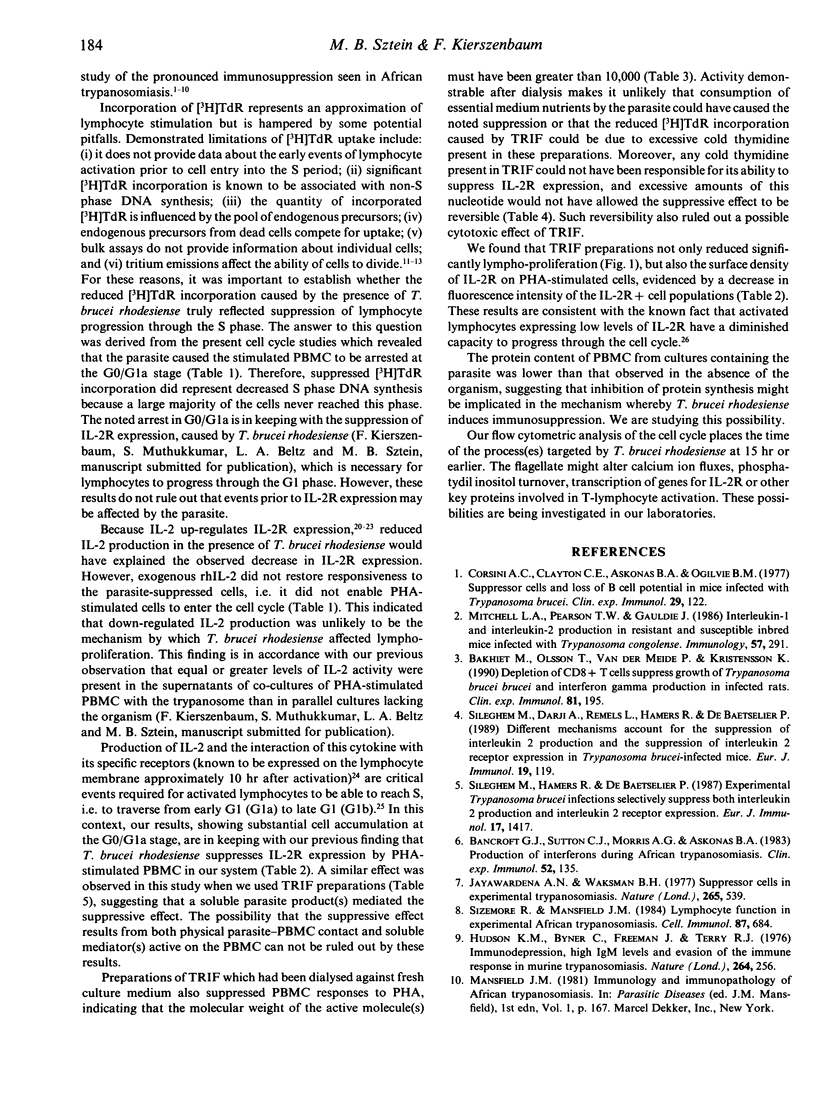
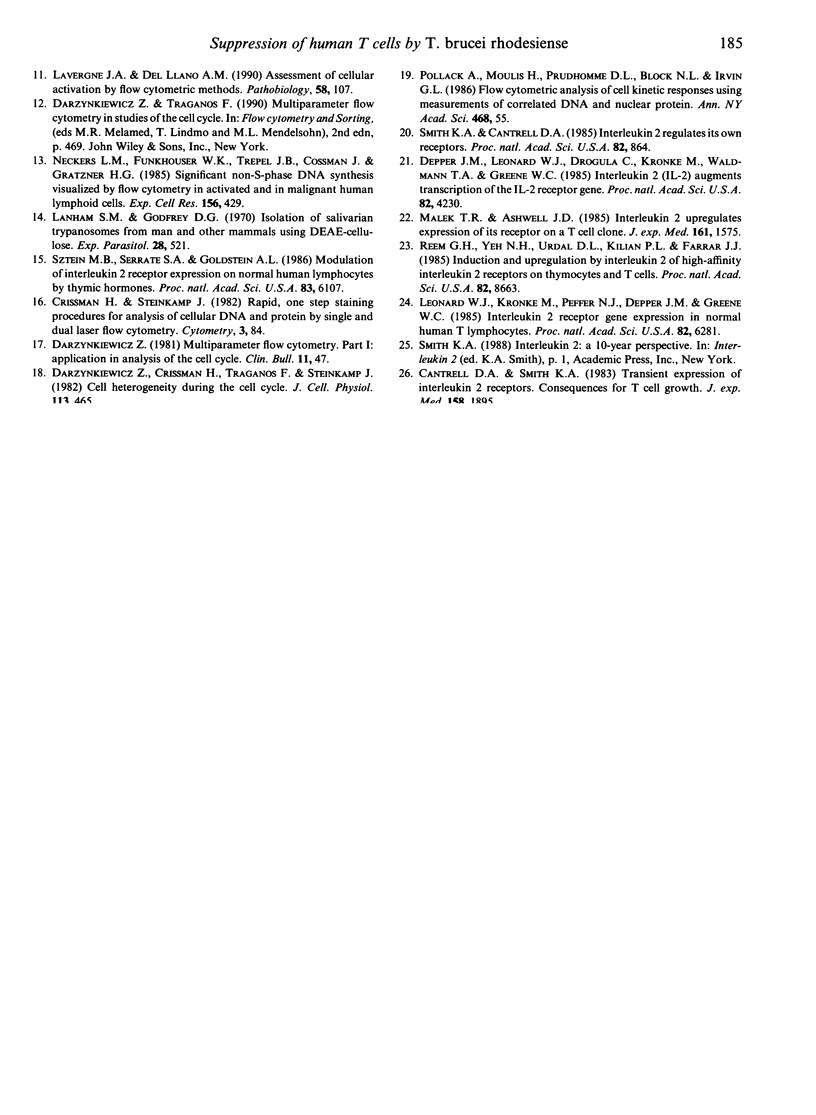
Selected References
These references are in PubMed. This may not be the complete list of references from this article.
- Bakhiet M., Olsson T., van der Meide P., Kristensson K. Depletion of CD8+ T cells suppresses growth of Trypanosoma brucei brucei and interferon-gamma) production in infected rats. Clin Exp Immunol. 1990 Aug;81(2):195–199. doi: 10.1111/j.1365-2249.1990.tb03317.x. [DOI] [PMC free article] [PubMed] [Google Scholar]
- Bancroft G. J., Sutton C. J., Morris A. G., Askonas B. A. Production of interferons during experimental African trypanosomiasis. Clin Exp Immunol. 1983 Apr;52(1):135–143. [PMC free article] [PubMed] [Google Scholar]
- Corsini A. C., Clayton C., Askonas B. A., Ogilvie B. M. Suppressor cells and loss of B-cell potential in mice infected with Trypanosoma brucei. Clin Exp Immunol. 1977 Jul;29(1):122–131. [PMC free article] [PubMed] [Google Scholar]
- Crissman H. A., Steinkamp J. A. Rapid, one step staining procedures for analysis of cellular DNA and protein by single and dual laser flow cytometry. Cytometry. 1982 Sep;3(2):84–90. doi: 10.1002/cyto.990030204. [DOI] [PubMed] [Google Scholar]
- Darzynkiewicz Z., Andreeff M. Multiparameter flow cytometry. Part I: application in analysis of the cell cycle. Clin Bull. 1981;11(2):47–57. [PubMed] [Google Scholar]
- Depper J. M., Leonard W. J., Drogula C., Krönke M., Waldmann T. A., Greene W. C. Interleukin 2 (IL-2) augments transcription of the IL-2 receptor gene. Proc Natl Acad Sci U S A. 1985 Jun;82(12):4230–4234. doi: 10.1073/pnas.82.12.4230. [DOI] [PMC free article] [PubMed] [Google Scholar]
- Hudson K. M., Byner C., Freeman J., Terry R. J. Immunodepression, high IgM levels and evasion of the immune response in murine trypanosomiasis. Nature. 1976 Nov 18;264(5583):256–258. doi: 10.1038/264256a0. [DOI] [PubMed] [Google Scholar]
- Jayawardena A. N., Waksman B. H. Suppressor cells in experimentally trypanosomiasis. Nature. 1977 Feb 10;265(5594):539–541. doi: 10.1038/265539a0. [DOI] [PubMed] [Google Scholar]
- Lanham S. M., Godfrey D. G. Isolation of salivarian trypanosomes from man and other mammals using DEAE-cellulose. Exp Parasitol. 1970 Dec;28(3):521–534. doi: 10.1016/0014-4894(70)90120-7. [DOI] [PubMed] [Google Scholar]
- Lavergne J. A., del Llano A. M. Assessment of cellular activation by flow cytometric methods. Pathobiology. 1990;58(2):107–117. doi: 10.1159/000163572. [DOI] [PubMed] [Google Scholar]
- Leonard W. J., Krönke M., Peffer N. J., Depper J. M., Greene W. C. Interleukin 2 receptor gene expression in normal human T lymphocytes. Proc Natl Acad Sci U S A. 1985 Sep;82(18):6281–6285. doi: 10.1073/pnas.82.18.6281. [DOI] [PMC free article] [PubMed] [Google Scholar]
- Malek T. R., Ashwell J. D. Interleukin 2 upregulates expression of its receptor on a T cell clone. J Exp Med. 1985 Jun 1;161(6):1575–1580. doi: 10.1084/jem.161.6.1575. [DOI] [PMC free article] [PubMed] [Google Scholar]
- Mitchell L. A., Pearson T. W., Gauldie J. Interleukin-1 and interleukin-2 production in resistant and susceptible inbred mice infected with Trypanosoma congolense. Immunology. 1986 Feb;57(2):291–296. [PMC free article] [PubMed] [Google Scholar]
- Neckers L. M., Funkhouser W. K., Trepel J. B., Cossman J., Gratzner H. G. Significant non-S-phase DNA synthesis visualized by flow cytometry in activated and in malignant human lymphoid cells. Exp Cell Res. 1985 Feb;156(2):429–438. doi: 10.1016/0014-4827(85)90549-x. [DOI] [PubMed] [Google Scholar]
- Pollack A., Moulis H., Prudhomme D. L., Block N. L., Irvin G. L., 3rd Flow cytometric analysis of cell kinetic responses using measurements of correlated DNA and nuclear protein. Ann N Y Acad Sci. 1986;468:55–66. doi: 10.1111/j.1749-6632.1986.tb42028.x. [DOI] [PubMed] [Google Scholar]
- Reem G. H., Yeh N. H., Urdal D. L., Kilian P. L., Farrar J. J. Induction and upregulation by interleukin 2 of high-affinity interleukin 2 receptors on thymocytes and T cells. Proc Natl Acad Sci U S A. 1985 Dec;82(24):8663–8666. doi: 10.1073/pnas.82.24.8663. [DOI] [PMC free article] [PubMed] [Google Scholar]
- Sileghem M., Darji A., Remels L., Hamers R., De Baetselier P. Different mechanisms account for the suppression of interleukin 2 production and the suppression of interleukin 2 receptor expression in Trypanosoma brucei-infected mice. Eur J Immunol. 1989 Jan;19(1):119–124. doi: 10.1002/eji.1830190119. [DOI] [PubMed] [Google Scholar]
- Sileghem M., Hamers R., De Baetselier P. Experimental Trypanosoma brucei infections selectively suppress both interleukin 2 production and interleukin 2 receptor expression. Eur J Immunol. 1987 Oct;17(10):1417–1421. doi: 10.1002/eji.1830171005. [DOI] [PubMed] [Google Scholar]
- Sizemore R. C., Mansfield J. M. Lymphocyte function in experimental African trypanosomiasis. VII. Loss of antigen-nonspecific suppressor-T-cell activity. Cell Immunol. 1984 Sep;87(2):684–691. doi: 10.1016/0008-8749(84)90036-4. [DOI] [PubMed] [Google Scholar]
- Smith K. A., Cantrell D. A. Interleukin 2 regulates its own receptors. Proc Natl Acad Sci U S A. 1985 Feb;82(3):864–868. doi: 10.1073/pnas.82.3.864. [DOI] [PMC free article] [PubMed] [Google Scholar]
- Sztein M. B., Serrate S. A., Goldstein A. L. Modulation of interleukin 2 receptor expression on normal human lymphocytes by thymic hormones. Proc Natl Acad Sci U S A. 1986 Aug;83(16):6107–6111. doi: 10.1073/pnas.83.16.6107. [DOI] [PMC free article] [PubMed] [Google Scholar]


